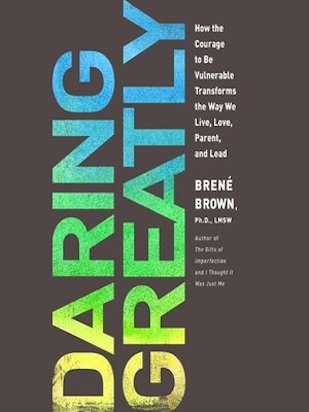Daring Greatly, penned by renowned researcher and storyteller Brené Brown, is a transformative exploration into the concept of vulnerability and its profound impact on human connection, creativity, and fulfillment. In this groundbreaking book, Brown delves into the intricacies of vulnerability, challenging societal misconceptions surrounding it, and illuminating the transformative power it holds in our personal and professional lives.
Chapter 1: Scarcity and Vulnerability
The book opens with a discussion on the pervasive sense of scarcity that plagues modern society. Brown argues that our fear of scarcity fuels our resistance to vulnerability, as we strive to armor ourselves against potential shame and disappointment. She introduces the concept of “foreboding joy,” explaining how our anticipation of loss often prevents us from fully embracing and enjoying moments of happiness.
“What we understand when we see people who are allowing themselves to be seen—really seen—is courage.”
Brown emphasizes the connection between vulnerability and courage, challenging the perception that vulnerability is synonymous with weakness. She encourages readers to recognize vulnerability as the birthplace of innovation, creativity, and genuine connection.
Chapter 2: Debunking the Vulnerability Myths
Brown confronts the common myths surrounding vulnerability, dispelling the notion that vulnerability is a sign of weakness. Drawing on extensive research, she presents vulnerability as the foundation of meaningful connections and emphasizes the importance of embracing it to foster genuine relationships.
“Vulnerability is not winning or losing; it’s having the courage to show up and be seen when we have no control over the outcome.”
Brown shares personal anecdotes and real-life examples to illustrate how vulnerability allows us to experience life more fully and connect authentically with others. By debunking these myths, she challenges readers to redefine vulnerability as a source of strength rather than a liability.
Chapter 3: Understanding Shame
The author delves into the concept of shame, exploring its detrimental effects on individuals and society as a whole. Brown contends that shame is the enemy of vulnerability, inhibiting our ability to connect with others and stifling our creativity. She introduces the concept of “shame resilience” as a crucial skill for navigating the challenges of vulnerability.
“If we can share our story with someone who responds with empathy and understanding, shame can’t survive.”
Brown provides practical strategies for cultivating shame resilience, urging readers to confront and challenge the shame that often accompanies vulnerability. By fostering empathy and understanding, individuals can build stronger connections and navigate the complexities of being truly seen.
Chapter 4: The Vulnerability Armory
This chapter explores the various ways individuals armor themselves against vulnerability, from perfectionism to numbing behaviors. Brown introduces the concept of the “vulnerability armory” and highlights its role in hindering authentic connection. She argues that by recognizing and dismantling these defense mechanisms, individuals can cultivate a more genuine and fulfilling life.
“Understanding the difference between healthy striving and perfectionism is critical to laying down the shield and picking up your life. Research shows that perfectionism hampers success. In fact, it’s often the path to depression, anxiety, addiction, and life-paralysis.”
Using relatable examples, Brown guides readers through the process of dismantling their vulnerability armory, encouraging them to embrace imperfection and cultivate self-compassion. She emphasizes the importance of fostering a culture that values authenticity over perfection.
Chapter 5: The Arena of Vulnerability
The metaphor of “the arena” serves as a central theme in this chapter, representing the space where individuals confront their fears and embrace vulnerability. Brown introduces the concept of the “Daring Greatly” mindset, inspired by Theodore Roosevelt’s famous quote about the person “in the arena.” This mindset encourages individuals to step into the arena of life with courage and vulnerability, despite the potential for criticism and failure.
“If you’re not in the arena also getting your ass kicked, I’m not interested in your feedback.”
Brown explores the importance of vulnerability in leadership, emphasizing that true leaders are those who are willing to take risks and be vulnerable. By sharing her research on leadership and vulnerability, she provides valuable insights for individuals striving to create authentic connections in both personal and professional settings.
Chapter 6: Shame, Empathy, and Connection
Building on the theme of shame resilience, Brown discusses the role of empathy in fostering genuine connections. She argues that empathy is the antidote to shame, creating a space for understanding and support. The chapter explores the dynamics of shame and empathy, showcasing how the ability to empathize with others’ vulnerabilities strengthens relationships and promotes a culture of compassion.
“Empathy’s the antidote to shame. The two most powerful words when we’re in struggle: me too.”
Through poignant examples and research findings, Brown illustrates how empathy serves as a bridge to connection, allowing individuals to share their vulnerabilities without fear of judgment. She emphasizes the transformative impact of empathy on personal relationships, organizational culture, and societal well-being.
Chapter 7: Wholehearted Parenting
In this chapter, Brown applies the principles of vulnerability and shame resilience to the realm of parenting. She explores the challenges parents face in embracing vulnerability and dispels the myth of the “perfect parent.” By sharing her personal experiences and research findings, Brown offers practical advice for cultivating a culture of wholehearted parenting that prioritizes authenticity, empathy, and connection.
“Our ability to be vulnerable and share who we are with others is a marker of wholehearted parenting.”
Brown encourages parents to model vulnerability for their children, creating a foundation for healthy relationships and emotional well-being. She emphasizes the importance of embracing imperfection and fostering a sense of belonging within the family unit.
Chapter 8: Vulnerability in the Workplace
In this chapter, Brown explores the intersection of vulnerability and the workplace, challenging traditional notions of leadership and success. She argues that fostering a culture of vulnerability is essential for innovation, creativity, and employee engagement. By sharing insights from her research on organizations, Brown provides actionable strategies for leaders and employees to create workplaces that value authenticity and collaboration.
“Vulnerability is the birthplace of innovation, creativity, and change.”
Brown discusses the concept of the “mythical leader” and highlights the importance of vulnerability in effective leadership. Through real-world examples, she demonstrates how vulnerability can transform workplace dynamics, leading to increased trust, resilience, and overall job satisfaction.
Chapter 9: Creativity and Vulnerability
In this chapter, Brown explores the intrinsic connection between vulnerability and creativity. She argues that creative expression requires a willingness to be vulnerable, as it involves sharing one’s authentic self with the world. Brown introduces the concept of “creative dissonance” and emphasizes the importance of embracing discomfort in the creative process.
“Vulnerability is the birthplace of love, belonging, joy, courage, empathy, and creativity. It is the source of hope, empathy, accountability, and authenticity. If we want greater clarity in our purpose or deeper and more meaningful spiritual lives, vulnerability is the path.”
Through anecdotes and research findings, Brown illustrates how vulnerability fuels the creative spark, inspiring individuals to take risks and express their unique perspectives. She encourages readers to view vulnerability as a catalyst for innovation and self-discovery.
Conclusion: Daring Greatly for a Fulfilling Life
Daring Greatly concludes with a powerful call to action, urging readers to embrace vulnerability as the path to a more fulfilling and meaningful life. Brown emphasizes that by daring greatly, individuals can cultivate genuine connections, foster creativity, and lead lives filled with purpose and authenticity. The book leaves readers with a profound understanding of vulnerability as a source of strength, courage, and connection. As we reflect on the key takeaways from Daring Greatly, it becomes evident that Brown’s insights are not just theoretical concepts but practical tools that can be applied to transform our daily lives.




